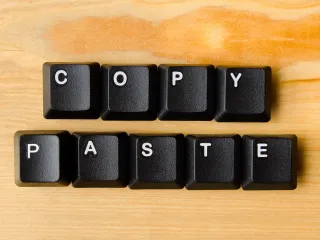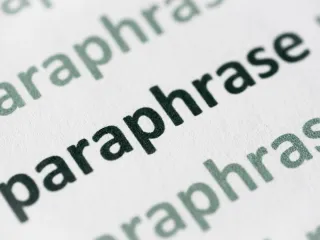Are Article Rewriter Tools Ethical?
Article rewriters, or article spinners, are increasing in popularity as the demand for readable content increases day by day. However, the discussion on the ethics of article rewriters falls into a gray area.
Article writer tools will take previously published work and change or rephrase it into a new piece. These tools “spin,” or rewrite, human-written content to create a similar yet different version of that piece. The “spun” duplicate content is unique from the original article, and can be useful for professional writers who need similar versions of their work for use in different spaces. In this way, using an article spinner can be done ethically. However, those who use an article writer to spin someone else’s work and pass it off as their own is a violation of copyright law, and is a misuse of the software.
How and why you use an article rewriter software will determine whether or not the situation is ethical or not. The following article will further in detail what an article rewriter does, why individuals may opt to use one, and how to ensure your use of this tool is done ethically.
What Is An Article Rewriter?
Article rewriter tools, also known as article spinners, are paraphrasing tools used to change and rephrase already written words to create unique content. Various websites exist to offer these tools to customers, and many writers use these tools to eliminate the time and work that it takes to write a new article. For a busy writer, turning to content spinning can mean saving time on brainstorming, writing, copyediting, and fixing other mistakes. However, using article spinners is generally a bad practice, and creates low-quality content that needs a lot of work before it’s ready to publish or turn in.
In the spinning process, words are replaced synonyms, switched from active voice to passive voice, and changed from direct speech into indirect speech. All these adjustments are done through algorithms and natural language processing to create technically new content from its original form. As a writer employing one of these tools, all you have to do is copy and paste an old article into the online tool and it will do the rest.
The online tool will create enough dissimilarity between the old article and the new spun article that plagiarism checkers most likely wouldn’t realize that the two pieces are actually from the same article. Article spinners spin words, sentences, and even whole paragraphs, while still maintaining the original core idea and point from the inspiration article. The application programming interface also increases the readability of the text by changing complex terms to more appropriate and easily understandable ones.
However, any native English speaker who finds the spun content will instantly know that it was written by a bot. Even the best article rewriters are notorious for coming out as awkward to read, with word choices that appear to be glaringly out of place. Although there are plenty of free article rewriter tools, like Quillbot, Spintax, CleverSpinner, Chimp Rewriter, Spinbot, and Copyscape, none of these services can create high-quality articles that are ready to be published. It’s easy to bet that any teacher, manager, or customer that reads spun content will know that it was created by a robot.
Who Should Use an Article Rewriter?
Article spinning tools are best reserved for professionals and skilled writers who understand the dangers and legal repercussions of plagiarism. Additionally, since these people are already familiar with the industries they are writing about they will have the knowledge to catch any unsuspecting errors made by these online tools. Prior industry knowledge also means these individuals are educated on the topic of the article being fed to an article spinner and will help ensure it does not accidentally cross ethical or moral lines in regards to plagiarism or copyright laws.
Article spinners are not for beginners. Because these tools use previously written content, there is a chance the spun content produced may contain instances of plagiarism from the original source. If a student or employee is caught plagiarizing, they could fail a class, be kicked out of school, or be fired from a job. Legally, you may have to pay damages if the copyright is prosecuted.
Professional writers and SEO experts may have ethical uses for article spinning tools. For example, a marketing professional may need to create multiple variations of social media posts to promote a new blog, product, or event. While they could simply use the same two- or three-sentence post to promote the initiative, social media best practices encourage the use of different wording. In this case, the writer could drop their initial version of the social media post into an article spinner, and create a few different versions to use across different social media platforms, or post on different days.
Students also may find an ethical use for spin rewriters when they are looking for help in paraphrasing content for their research reports. Students can paste exact text from the original source into the text rewriting tool, and will instantly receive a new version of that content. However, this should only be used as a starting point for paraphrasing the concept. Even after finessing the language, students should be sure to cite the original source when entering the paraphrased content into their papers.
Dangers of Using an Article Rewriter
Article spinner tools present two extremely common dangers: actual plagiarism, and diminishing your own credibility by presenting bad writing as your own. These two things will significantly impact your business, education, job, and reputation if you don’t catch them before submitting or publishing the work.
Badly spun content can still be identified as plagiarism, whether it’s found out through the use of a plagiarism checker or through manual research by a professor or manager. In both the academic and professional worlds, any use of another individual’s work without a corresponding citation that accredits the original author is still considered plagiarism. As previously stated, plagiarism can get you into massive amounts of trouble. Therefore, if you do use article spinner software, it’s essential that you cite your work. Luckily, citation generators like Quetext make it easy to instantly and effortlessly cite your sources in APA, MLA, and Chicago style.
Additionally, presenting incoherent or bad writing as your own can ruin your reputation as a writer, and for students can impact an academic grade. AI algorithms are not well-suited for content creation that is easy to read since they lack the ability to replicate a tone or exact sentence structure that is natural in humans. If you must use an article rewriter, it’s essential that you proofread the new text format and fix all instances of awkward language (and there will be many).
Ultimately, spun content may provide easy access to free content, but it still requires a lot of work to make the rewritten article readable, and can still require citations to avoid being accused of plagiarism.
Consider This Real Example of Spun Content
Spun content that is unedited and directly from an online article rewriter tool should never be used as the final version of a student’s work or for professional writing. As previously stated, the writing abilities of artificial intelligence software can be of low quality.
While an article spinner does create a whole new piece of work from the original one, the work may still contain identifiable aspects from the original source. This is because the software is AI-driven and simply inputs synonyms for each word or phrase in the original content to create their spun content. The example outlined below will show you the many similarities between a piece of original content and what an article rewriting tool produced as the spun version.
Original content: Why Is Plagiarism Wrong?
“Plagiarism is not a victimless crime. On the one hand, it can put you into serious hot water with your school or employer. Perpetrators of plagiarism lose a lot of credibility, and even if you aren’t totally disregarded in the professional sphere after plagiarizing, you will always be remembered as a cheater; a plagiarizer; a thief.”
– What is Plagiarism And What’s So Wrong About It?
Spun content: Why Is Plagiarism Wrong?
Counterfeiting is definitely not a harmless wrongdoing. From one viewpoint, it can place you into genuine high temp water with your everyday schedule. Culprits of literary theft lose a ton of validity, and regardless of whether you’re not completely dismissed in the expert circle subsequent to counterfeiting, you will constantly be recognized as a miscreant; a plagiarizer; a cheat.
As you can see by comparing the original with the spun content, they are almost identical in terms of sentence structure and theme but simply feature synonyms of the first words. Additionally, the spun content has awkward language that is not smooth to read and instantly stands out as suspicious. If you wanted a more cohesive and higher-level piece of work, significant proofreading, editing, and changes are necessary.
Because of the awkward language that isn’t quite human-readable, any report or assignment that was 100% created by an online article rewriter will most certainly be suspicious to a boss or teacher who reads it.
How To Use An Article Rewriter Ethically
The best and easiest way to make sure you are using an article rewriter tool in an ethical manner is to only feed it your own original writing. Using an article rewriter tool with an essay, blog post, or article that you’ve previously published, or with the words of other writers, will instantly leave you open to accusations of self-plagiarism. In these cases, you must always use citations when using an article rewriter to paraphrase content.
However, the spinner tool can give you assistance with paraphrasing and creating multiple variations of your own writing, and you can remain calm knowing there is no chance of accidental plagiarism as long as your writing has not been previously published. These variations of new work can be used for a number of things by a number of different professionals. For example, social media managers can create a variety of social media posts, bloggers can make different blog posts, public relations professionals can create different pitches, etc. All of these examples should be used as starting points only, and anyone who uses an article rewriter should always proofread the content to ensure that they’ve created high-quality writing before publishing their final versions.
If you’re intent on using an article spinner in your writing, the best article rewriter tools will score highly in grammatical output and uniqueness. It must be stressed that any use of paid or free article spinners will not result in high-quality content, and will require the user to rewrite content in order to make it more easily understood. Any use of an article rewriter should also be accompanied by the use of citations to protect the author from accusations of plagiarism.
Of course, the best thing to do when it comes to creating unique articles is to start with your own words and ideas, and always use a plagiarism checker and grammar checker to make sure your final work is both plagiarism-free and ethically sound. Both of Quetext’s plagiarism and citation generation tools are available as a free version to help student and professional writers make sure their work is free of plagiarism.









